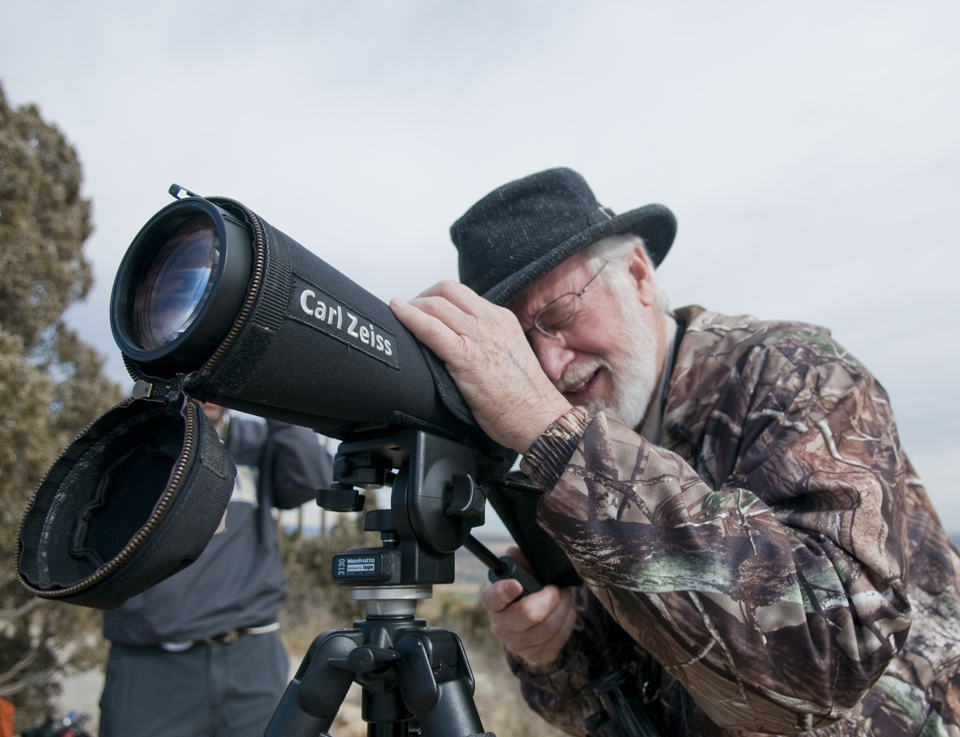It’s cold as I work my way up the dark west side of Dinosaur Ridge. The fresh snow crunches then slips under my feet as I clamber with my binoculars and scope to the observation view point. The morning sun hits and warms me up. I debate taking off a layer just before I feel the steady breeze and decide to keep my jacket on. I set up my scope and fill out my datasheet.
Just as I finish filling in the weather data I see my first migrating raptor of the morning, an adult Ferruginous Hawk flying just below me on the ridge. Dinosaur Ridge, located in the Dakota Hogback Natural Area west of Morrison, Colorado, is the best place in the world to see Ferruginous Hawks during migration. Forty were counted in one day and 241 in one spring a few years back.
Just as another HawkWatch observer arrives for the daily count, I see a juvenile Cooper’s Hawk flying low overhead alternating between flaps and glides. I see its bright yellow eye as it passes a few feet above me. I’m starting to feel that this might be a good day. Pretty soon I’m seeing small groups of migrating juvenile Red-tailed Hawks passing by. The southern breeze is helping guide them along.
Raptors use a number of techniques to save energy while migrating. They don’t want to fight the winds, but instead will use them to their advantage. At Dinosaur Ridge, we see a lot of raptors utilizing the lift created when wind blows across the ridgeline. Also, birds of prey will use thermal updrafts on the prairie to help them gain altitude. For birds, holding out their wings is the energy equivalent of us sitting in a chair.
During the morning, I see a pair of resident Golden Eagles that nest nearby using the updrafts to dance in the air. They are showing off to each other and letting any other eagles know that this is their territory. As I watch these display flights, a Prairie Falcon perches on the power pole to my north. I get my scope on it and see that it has caught a Western Meadowlark. It is currently plucking out yellow and black feathers so it can eat the highly nutritious breast muscles of this ubiquitous grassland species.
After seeing more than a dozen migrating raptors and several local species that morning, I head down the ridge and head back to Fort Collins. On the drive back, I try not to continue HawkWatching. It’s a little difficult as almost every other light pole has a Red-tailed Hawk or American Kestrel on it. Eventually, I get home and hear that I just missed the migrating Northern Goshawk that flew over the ridge as I was driving away. I guess there’s always something to bring you back!
Get Involved with HawkWatch
Dinosaur Ridge, located west of Morrison, is Colorado’s only regularly staffed HawkWatch site. Using a universally accepted data‐collection method for the United States, citizen science volunteers watch and count eagles, hawks, falcons and vultures as part of this program coordinated locally by Rocky Mountain Bird Observatory. Collected data are submitted to an online public database and contribute to continental monitoring of raptor migration, assessments of population trends, and public outreach and education. The massive database is maintained by the Hawk Migration Association of North America.

HawkWatch volunteers count migrating raptors as part of this citizen science program. The program allows people to participate in real science while they learn about raptor behavior and identification. Photo by William Bond.
All skill levels are encouraged to participate. The watch typically operates from 9 a.m. to 4 p.m. daily from early March through May 7. Peak migration generally occurs in mid‐April. Unlike typical birding where people walk, hike or drive to see birds, a HawkWatch involves scanning the sky from a stationary location. Binoculars are a must, and cameras and spotting scopes can also be helpful. Volunteers encounter a steep half-mile hike to the watch site, constantly changing and windy weather, and the occasional “snow out.” One volunteer is designated as the official counter for each HawkWatch day. Other volunteers help spot raptors and work with the counter to identify them.
The HawkWatch site is atop the Dakota formation, a hogback southeast of Interstate 70 and County Road 93, and west of C‐470 between Golden and Morrison. Access is from the Stegosaurus parking lot at the southeast corner of exit 259 on I‐70. Take the trail leading upslope from the parking lot and south along Dinosaur Ridge to the ridge top; the HawkWatch site is to the left of the trail.
To learn more about HawkWatch or sign up to volunteer, send an email to [email protected] or call me at 970-482-1707 ext. 25.
~ Jeff Birek, Outreach Biologist


